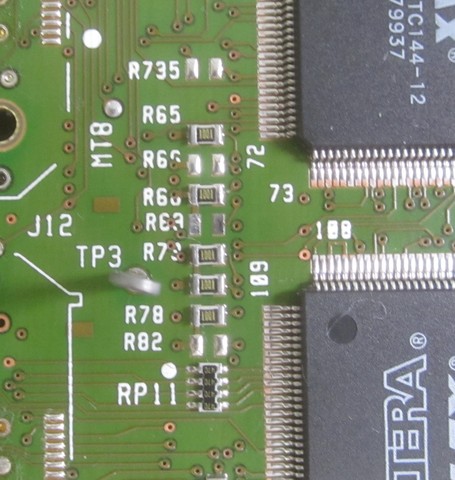In the course of repairing some 1675x cards, I discovered that HP/Agilent is using resistors to set the model ID, and hence the capture memory size on these old logic analyzer cards. The main clues were:
- All models already have the full complement of memory for their series,
- There was sloppy soldering work (solder splatter, flux residue) on unpopulated resistor pads that were in an obvious grouping (indicating that some had been removed after manufacture),
- The only indication of the model number was a solitary adhesive sticker,
- And finally, HP/Agilent is known to use ID resistors in other products.
I haven't seen this info anywhere else, so I'm posting here.
I've verified the following ID conversions work (with full memory testing):
16751A --> 16752A
16754A --> 16756A
16755A --> 16756A
Specs and other details for the cards discussed in this post:
http://literature.cdn.keysight.com/litweb/pdf/5968-9661E.pdf----------
Series: 16750A, 16751A, 16752A
Memory: 34 x Micron 48LC4M16A2-8E
Max model: 16752A with 32MSa
There are nine ID resistor footprints arranged in a column: R735, R65, R66, R68(?), R63, R73, unlabeled, R78, and R82. They are near the pair of Altera LQFP's near the backplane connector. (It's possible R735 does something else besides ID, but it's unpopulated and near the others so I'm including it.) To make a 16752A, all the resistors are populated except R735, R66, R63, and R82. Resistors are 1k 0805.

There are also "B" versions of each of these cards. The (bad) photos I can find look like they have the same layout, so I would expect it to work with them also with possibly different resistor labels or combinations (maybe one controls the A vs. B?).
----------
Series: 16753A, 16754A, 16755A, 16756A
Memory: 18 x Micron 46V16M16-75
Max model: 16756A with 64Msa
There are eight ID resistor footprints arranged in a matrix: two rows A and B, and four columns 1, 2, 3, and 4. They are near the Xilinx FPGA U128, which is near the backplane connector. To make a 16756A, all resistors are populated except B3 and B4. Resistors are 1k 0805.

There's also an EEPROM on this card, but it doesn't seem to have anything to do with ID. It's probably only used for calibration data.
----------
Other Cards (which I don't have so I can't try it)
The 16740A, 16741A, and 16742A from photos look very similar (perhaps identical?) to the 16750A/51A/52A series and with ID resistors in the same PCB area. Hopefully a 1674x owner can figure this one out since it might need different resistor positions populated. Please post your results if you try it.
I'll also note that the 1674x and 1675x series cards are identical spec-wise except for memory configurations, occurrence counters, and maximum state speed. So, I suppose it's possible that a 1674x could be turned into a 1675x by using only ID resistors, but it would require a closer look at the memory configuration on the board and subsequent testing at higher speeds. Again, something for a 1674x owner to try.
It may also be possible to turn a 16718A (8Msa) into a 16719A (32MSa), but I can't find enough photos to know if the board layouts and memory configuration are the same. The 16719A at least has a similar board layout to the 16740A/41A/42A and 16750A/51A/52A series, so it probably has ID resistors.
Somewhat related to this topic, I've also heard of a hack to turn a 16533A 250MHz 1Gsa/sec scope card into a 16534A 500MHz 2Gsa/sec scope card via a resistor ID. If anyone knows the specifics, please feel free to share. Or if you have a 16533A, post a high-res photo (front and back) and I can probably figure it out from there.
----------
Good luck if you try any of this, and please post your results here if you do!